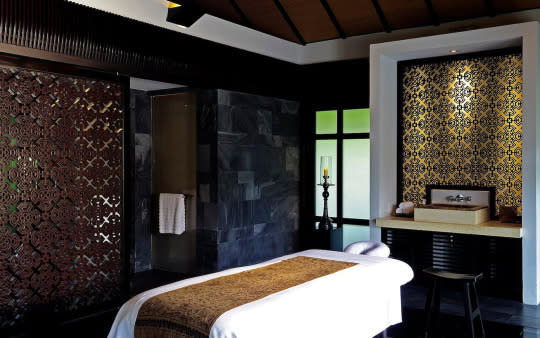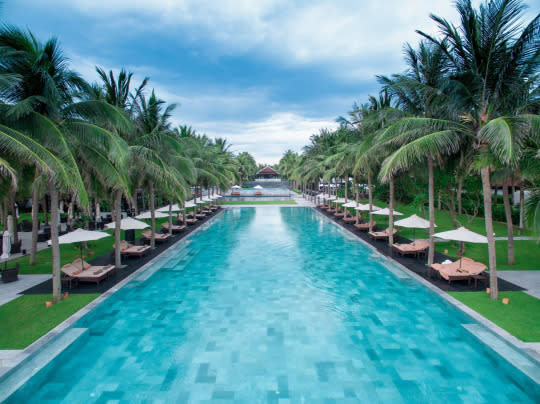Why I Spent a Month's Rent on One Night at the World's Best Spa Hotel

The Nam Hai recently won Mr and Mrs Smith’s Best Spa Hotel award for 2015. A penny-pinching traveler decides if the price tag is worth it. (Photo: GHM Hotels)
By: Olivia Fleming
I was first introduced to The Nam Hai by Jeremy Clarkson, who, during a special 2009 episode of Top Gear, found refuge from heavy humidity alongside the luxury hotel’s three architecturally-enticing infinity pools and two-mile-long private white sand beach. Nestled amongst oversized coconut trees 15 minutes from Vietnam’s ancient city, Hoi An, Clarkson is seen sipping a Nam Hai Sling, a signature gin and pineapple cocktail. “If you’re passing, it’s worth dropping in. Actually, even if you’re not passing, it’s worth flying over there just so you are,” he says emphatically through the TV.
Five years later I found myself in Ho Chi Minh with my boyfriend, where, after a week’s worth of eating street food on a shoestring budget, we decided to venture north toward Laos. In need of a halfway-point pitstop, I could hear Clarkson’s sarcastically charming British accent egging me on. So I typed The Nam Hai, where rooms range from $700 to $3,000 per night and spa “rituals” cost, on average, $400, into Google “just to look.”
First let me be clear about my compulsion for budgeting. I am fond of coupons; I shop diligently, waiting for sales and “better” deals. I’m the kind of person who spends too long agonizing over what New York Metrocard to buy (unlimited or pay-per-ride), conscious of wasting unused rides, which never works out in my favor. When traveling around the U.S., my boyfriend and I are accustomed to camping and economical Airbnbs—neither of us had ever stayed at a five-star hotel before, nor had we ever experienced a real spa. (Massages in Chinatown don’t really count.) But when visiting faraway, exotic places, my approach to money seems to shift. Any idea of financial solvency is quickly replaced with a sort of “yolo” logic, where the argument, “We’ll probably never come back here, so we may as well ‘do it properly,’” often prevails.
Related: 10 Things You Need to Know Before You Go to Vietnam
At the train station in Ho Chi Minh we started scrolling through The Nam Hai’s perfectly-lit and expertly styled gallery images. “It looks nice, but is this really worth the money?” my boyfriend asked. Though I couldn’t say for sure, I did find some scientific reasoning to justify the splurge. Earlier this year, a study titled A Wonderful Life: Experiential Consumption and the Pursuit of Happiness, published in the Journal of Consumer Psychology, proved that experiences (things like travel, outdoor activities, visiting exhibitions, or eating at fancy restaurants) bring people the most lasting happiness. Material things, like the new TV we wanted to buy instead, do not. So in the name of “enduring satisfaction,” as Dr. Thomas Gilovich, a psychology professor at Cornell University who conducted the study, put it, we thought what the hell and booked a one-bedroom oceanfront villa at The Nam Hai, with a bathroom and outdoor shower garden twice the size of our Greenpoint, Brooklyn apartment.

Relax by the pool and stay a while. (Photo: The Nam Hai/Facebook)
Located on the pristine Ha My beach on Vietnam’s central coast and set in 87 acres of expansive, sculpted grounds, The Nam Hai is considered one of the world’s leading small hotels. (It currently has more than 1,200 “excellent” reviews on TripAdvisor.) There are 60 self-contained small villas, all featuring a raised four-poster bed facing the South China Sea, as well as 40 larger villas with up to five bedrooms, a private pool, and quarters for a butler. Since the hotel first opened in 2006, it has received a handful of awards, including Travel + Leisure’s World’s Best Designed Resort in 2008, and accolades from Conde Nast Traveler, Frommer’s Review and Australian Gourmet Traveler. This year it was crowned the World’s Best Spa Hotel by Mr and Mrs Smith.
Exhilarated, we arrived at the hotel in a private black car that had picked us up from the station, feeling like two troublesome kids that were—despite our adult age—impersonating rarefied grown-ups in a world totally foreign to us. The porter showed us to our villa in a sleek golf buggy, down winding paths flanked by towering tropical plants. Our composure dissolved the instant he closed the door; which I imagine is how Kevin in Home Alone 2 must have felt after checking into The Plaza Hotel. We immediately investigated the villa’s hidden gadgets (there are many), and marveled at the indulgent bathroom products, like bottles of fresh rose petals for the lacquered eggshell bath.
The level of luxury the hotel offers means it is not uncommon for staff to wipe sand from your water bottle should it fall off your lounge chair, no matter how much you protest. Turndown service includes lighting candles in each villa as the sun sets, where staff enclose your elevated “slumber pavilion” in flowing hand-spun white silk drapes. Sought-after contemporary Vietnamese artwork hangs in the high ceilinged living spaces (which also features a sunken writing desk, fountain pen included), and the lavish bathroom opens out onto a private garden with an outdoor rain shower.
Related: The River Rush | Take a (Beautiful!) Photo Tour of Phong Nha, Vietnam
But the “wellness retreat” itself, designed by architect Reda Amalou, is where the wow-factor really sets in. Described by Mr and Mrs Smith as a place “where Vietnamese chic meets cutting-edge design,” you won’t find your average, run-of-the-mill treatments here. Built according to a precise formula for zen, the spa features eight private relaxation bungalows that float serenely amongst lotus flowers on a koi fish-filled lagoon. Here, you are led through large French doors to an open air relaxation deck that juts out onto the lagoon, where a deep bathtub faces a cushioned daybed for two, and a vast selection of relaxing “rituals” and wellness “ceremonies” are offered. Each treatment begins with an oil-infused milk foot soak, and ends with you never wanting to leave. When Clarkson visited, he believed you could “get so relaxed here that your bones would melt,” calling it “the most astonishing spa in the whole world.”
According to Dr. Gilovich, we are “the sum total” of our experiences. One reason that experiential purchases can provide “more enduring satisfaction,” he explains, is that they “more deeply connect us to others.” It’s a logical explanation: we remember the really special moments with the people we love, long after the material things that we paid so much for fall apart.
Obviously these experiences don’t have to be expensive. But when my boyfriend and I look back at our three-year-long relationship, where beautiful things have been bought for our first apartment together and budget-friendly road trips have been taken, our stay at The Nam Hai unanimously remains the highlight. I asked him to recall the 24 hours we spent there, which, when we checked out, totaled an entire month’s rent. His face lights up. “That was probably, no joke, the best day of my life.”
More from Travel and Leisure:
A Phobic Writer Spends a Night at the ‘Shining’ Hotel
In Moscow, An Unexpected Creative Revolution
The Takeaway: a Creative Director’s Favorite Finds From Morocco
WATCH: 5 Ways to Avoid Common Hotel Scams
Let Yahoo Travel inspire you every day. Hang out with us on Facebook, Twitter, Instagram, and Pinterest. Watch Yahoo Travel’s original series “A Broad Abroad.”
